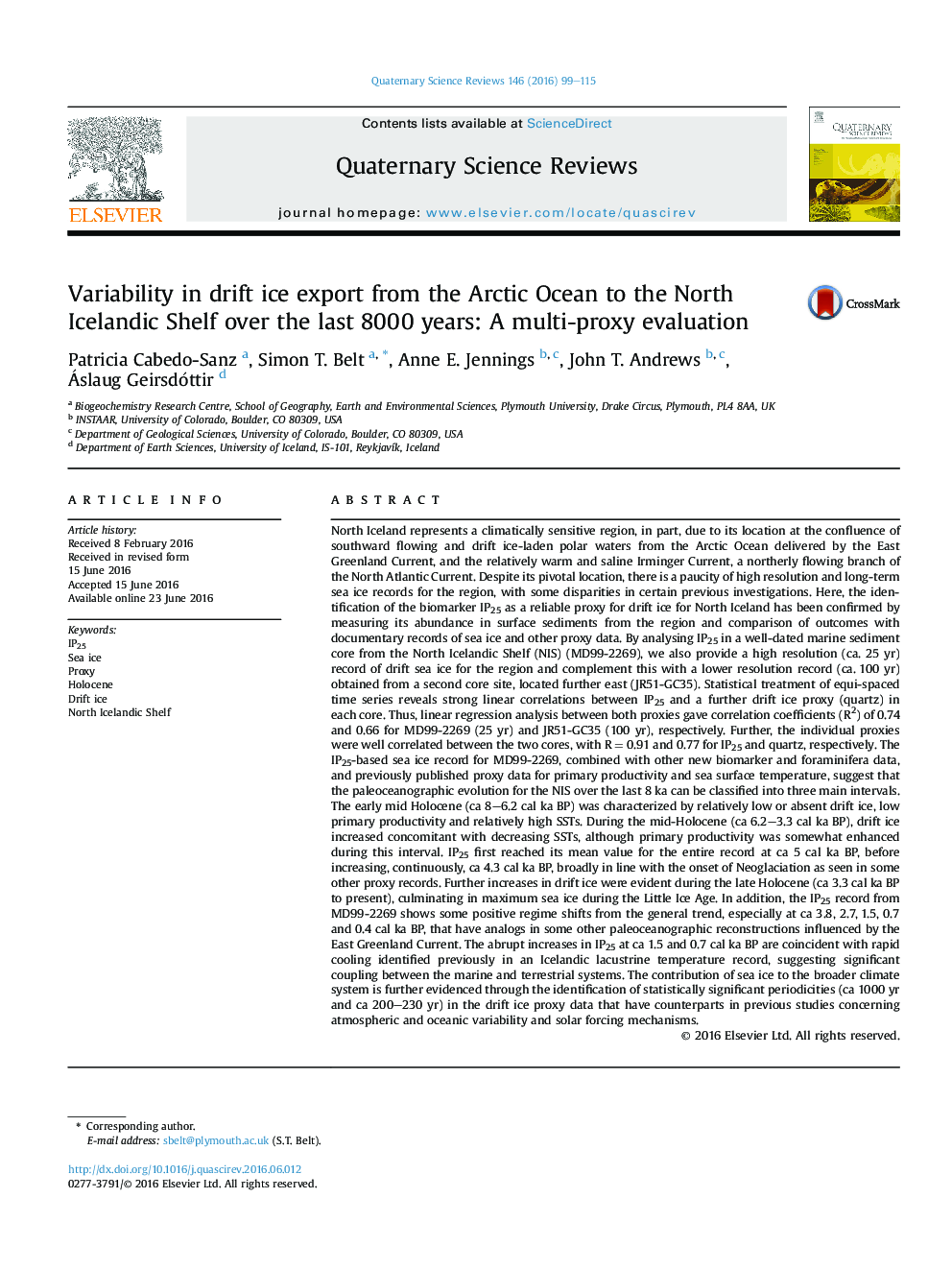| کد مقاله | کد نشریه | سال انتشار | مقاله انگلیسی | نسخه تمام متن |
|---|---|---|---|---|
| 4735267 | 1640789 | 2016 | 17 صفحه PDF | دانلود رایگان |
• The biomarker IP25 confirmed as a suitable drift ice proxy for North Iceland.
• North Iceland reconstruction reveals steady increase in drift ice since ca 8 cal ka BP.
• Maximum drift ice export from the Arctic Ocean occurred during the Little Ice Age.
• Sea ice record provides evidence for marine-terrestrial coupling.
• Periodicities in drift ice potentially associated with volcanic and solar forcing.
North Iceland represents a climatically sensitive region, in part, due to its location at the confluence of southward flowing and drift ice-laden polar waters from the Arctic Ocean delivered by the East Greenland Current, and the relatively warm and saline Irminger Current, a northerly flowing branch of the North Atlantic Current. Despite its pivotal location, there is a paucity of high resolution and long-term sea ice records for the region, with some disparities in certain previous investigations. Here, the identification of the biomarker IP25 as a reliable proxy for drift ice for North Iceland has been confirmed by measuring its abundance in surface sediments from the region and comparison of outcomes with documentary records of sea ice and other proxy data. By analysing IP25 in a well-dated marine sediment core from the North Icelandic Shelf (NIS) (MD99-2269), we also provide a high resolution (ca. 25 yr) record of drift sea ice for the region and complement this with a lower resolution record (ca. 100 yr) obtained from a second core site, located further east (JR51-GC35). Statistical treatment of equi-spaced time series reveals strong linear correlations between IP25 and a further drift ice proxy (quartz) in each core. Thus, linear regression analysis between both proxies gave correlation coefficients (R2) of 0.74 and 0.66 for MD99-2269 (25 yr) and JR51-GC35 (100 yr), respectively. Further, the individual proxies were well correlated between the two cores, with R = 0.91 and 0.77 for IP25 and quartz, respectively. The IP25-based sea ice record for MD99-2269, combined with other new biomarker and foraminifera data, and previously published proxy data for primary productivity and sea surface temperature, suggest that the paleoceanographic evolution for the NIS over the last 8 ka can be classified into three main intervals. The early mid Holocene (ca 8–6.2 cal ka BP) was characterized by relatively low or absent drift ice, low primary productivity and relatively high SSTs. During the mid-Holocene (ca 6.2–3.3 cal ka BP), drift ice increased concomitant with decreasing SSTs, although primary productivity was somewhat enhanced during this interval. IP25 first reached its mean value for the entire record at ca 5 cal ka BP, before increasing, continuously, ca 4.3 cal ka BP, broadly in line with the onset of Neoglaciation as seen in some other proxy records. Further increases in drift ice were evident during the late Holocene (ca 3.3 cal ka BP to present), culminating in maximum sea ice during the Little Ice Age. In addition, the IP25 record from MD99-2269 shows some positive regime shifts from the general trend, especially at ca 3.8, 2.7, 1.5, 0.7 and 0.4 cal ka BP, that have analogs in some other paleoceanographic reconstructions influenced by the East Greenland Current. The abrupt increases in IP25 at ca 1.5 and 0.7 cal ka BP are coincident with rapid cooling identified previously in an Icelandic lacustrine temperature record, suggesting significant coupling between the marine and terrestrial systems. The contribution of sea ice to the broader climate system is further evidenced through the identification of statistically significant periodicities (ca 1000 yr and ca 200–230 yr) in the drift ice proxy data that have counterparts in previous studies concerning atmospheric and oceanic variability and solar forcing mechanisms.
Journal: Quaternary Science Reviews - Volume 146, 15 August 2016, Pages 99–115
